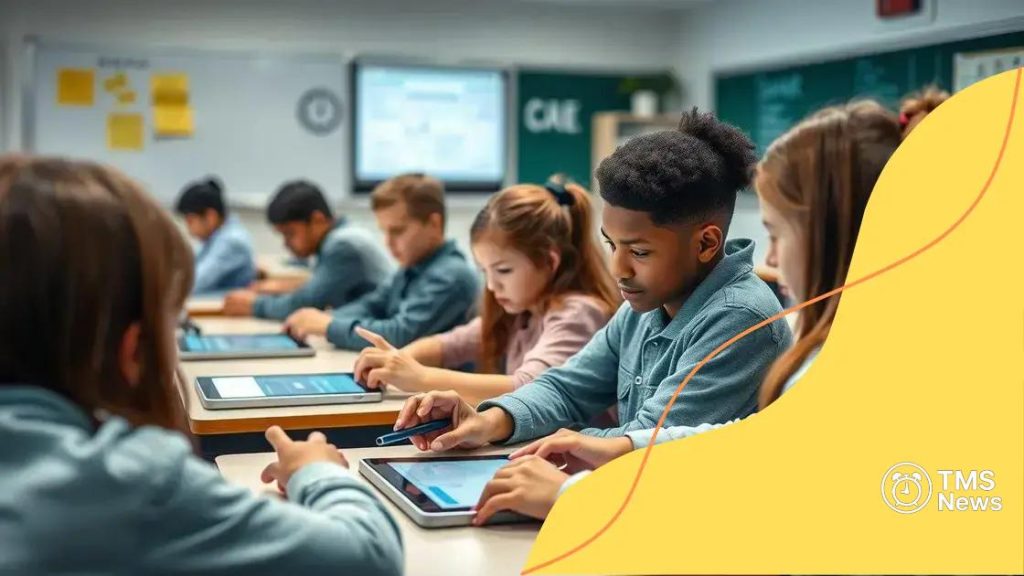AI integration in K-12 education: the future of learning

Anúncios
AI integration in K-12 education enhances personalized learning, teacher collaboration, and accessibility while preparing students for a technology-driven future through innovative educational tools.
AI integration in K-12 education is transforming the way our children learn and interact with curriculum. Have you ever wondered how technology can personalize education and foster creativity? In this article, we’ll dive into the exciting potential and real-world applications of AI in classrooms.
Anúncios
Understanding AI in education
Understanding AI in education begins with recognizing its potential to transform traditional teaching methods. Imagine classrooms where students engage with personalized content, tailored to their unique learning styles. This technology is reshaping how educators approach lesson plans.
What is AI in Education?
At its core, AI in education encompasses various tools and techniques that use data and algorithms to enhance learning experiences. By analyzing student performance, AI can identify strengths and weaknesses, allowing teachers to adjust their approach accordingly.
Benefits of AI in the Classroom
Implementing AI in education offers numerous advantages:
Anúncios
- Personalized Learning: AI can provide customized resources to meet individual student needs.
- Data-Driven Insights: Educators gain valuable feedback on student progress and areas for improvement.
- Enhanced Engagement: Interactive AI tools can make learning more appealing and fun for students.
As we explore the landscape of AI in education, it’s crucial to highlight how it can also assist teachers in administrative tasks. This allows them more time to focus on what matters most: teaching and inspiring their students. By streamlining grading processes and providing lesson suggestions, AI empowers educators to create more dynamic classroom environments.
Real-World Applications
In practice, schools worldwide are already exploring AI’s potentials. For instance, AI-driven platforms offer real-time assessments and instant feedback, enabling learners to grasp concepts quickly. Moreover, virtual tutors powered by AI assist students outside classroom hours, ensuring they receive the help they need to succeed.
This integration of technology not only enhances the learning experience but also prepares students for a future where digital skills are vital. Through understanding AI in education, we see a pathway towards a more efficient and inclusive approach to teaching and learning.
Benefits of AI integration in K-12
The benefits of AI integration in K-12 education are vast, transforming traditional learning environments into dynamic and personalized experiences. Educators and students alike can gain from these advancements, paving the way for a brighter educational future.
Enhanced Learning Experiences
One of the most prominent advantages of AI in education is its ability to provide tailored learning. With AI technology, lessons can adapt to each student’s pace and understanding. This means that students who need extra help can receive additional support while advanced learners can be challenged adequately.
Increased Efficiency for Educators
AI not only benefits students but also enhances the workflow for teachers. By automating routine tasks such as grading and attendance tracking, educators can focus more on interactive teaching. This efficiency leads to:
- Improved Student Engagement: Teachers have more time to engage students in meaningful discussions.
- Data-Driven Decision Making: Access to analytics helps teachers make informed choices tailored to student needs.
- Reduced Administrative Burden: With less time spent on paperwork, teachers can devote more energy to planning creative lessons.
Moreover, AI tools can provide real-time feedback during lessons, allowing students to understand concepts better and make corrections as they learn. These capabilities enrich classroom interactions and promote an environment where learning thrives.
Support for Diverse Learning Needs
In a diverse classroom, every student learns differently. AI plays a crucial role in supporting various learning styles. By offering multiple resources, such as videos, interactive activities, and quizzes, AI caters to individual preferences. This inclusivity ensures that all students have the opportunity to learn effectively.
Furthermore, AI applications can help identify students who may need additional assistance early on, promoting timely intervention. Early identification is key to ensuring that every student receives the support necessary to succeed.
As AI continues to evolve, the integration of AI in K-12 education will likely lead to even more transformative outcomes, encouraging innovation and better academic achievements.
Challenges schools face with AI

While the integration of AI in education offers many benefits, schools also face significant challenges that can impact implementation. Addressing these issues is crucial for maximizing the potential of AI technologies in the classroom.
Infrastructure Limitations
One major challenge is the lack of adequate infrastructure. Many schools, especially in underfunded areas, struggle with outdated technology. This not only hinders access to AI tools but also makes it difficult for teachers and students to utilize AI resources effectively. Ensuring that every classroom is equipped with the necessary hardware and software is essential for successful AI integration.
Training and Development
Another significant hurdle is the need for proper training for educators. Many teachers are not familiar with AI technologies and require professional development to effectively incorporate them into their teaching strategies. Some key aspects include:
- Understanding AI Tools: Teachers need to learn how to navigate and use various AI platforms confidently.
- Curriculum Integration: Finding ways to blend AI tools with existing curricula can be challenging.
- Ongoing Support: Continuous availability of technical support ensures that educators can resolve issues quickly.
Without this essential training, teachers may feel overwhelmed and unsure of how to utilize AI technologies, which can lead to underutilization of these valuable resources.
Ethical Concerns
Ethics also play a significant role in AI adoption. Issues such as data privacy and equitable access to technology raise important questions. Schools must ensure that student data is protected and that AI applications do not perpetuate biases. Furthermore, it is vital to provide equal access to AI tools, ensuring that no group of students is disadvantaged.
Addressing these ethical concerns can be complex, as it requires regular dialogue among educators, administrators, and technology providers. By fostering an ethical approach to AI, schools can better serve their student populations.
As schools navigate these challenges, it is essential to remember that overcoming them can lead to more effective learning environments. Embracing the difficulties associated with AI integration will ultimately pave the way for improved educational outcomes.
Practical examples of AI tools in classrooms
Practical examples of AI tools in classrooms highlight how technology can enhance learning and engagement among students. There are numerous applications that schools are effectively using to create dynamic educational environments.
Intelligent Tutoring Systems
Intelligent tutoring systems (ITS) provide personalized learning experiences by adapting to the student’s needs. These systems analyze the learner’s performance and offer tailored resources. They ensure that each student receives help at the right moment and level, which can significantly enhance understanding.
AI-Powered Assessment Tools
Another great example is AI-powered assessment tools that automatically grade assignments and provide feedback. This technology saves teachers time and allows for quicker responses to students. The benefits include:
- Immediate Feedback: Students receive instant results that can boost their learning.
- Focus on Learning: Teachers can spend more time on instruction rather than grading.
- Data Insights: Educators gain insights into class performance trends.
This approach not only streamlines the grading process but also enhances the overall educational experience for both teachers and students.
Virtual Learning Environments
Many classrooms are also utilizing virtual learning environments that leverage AI to create interactive lessons. These platforms can simulate real-world scenarios, making learning more engaging. For instance, language learning apps use AI algorithms to help students practice speech in a personalized manner, making lessons more effective.
The integration of AI tools in classrooms supports differentiated instruction, ensuring that each student learns in a way that suits them best. This can lead to greater retention of knowledge and improved performance across various subjects.
As AI technology continues advancing, its applications in education are bound to grow. Educators can harness these tools to create an enriching and modern learning environment, preparing students for a future where technology and education go hand in hand.
Future prospects of AI in K-12 education
The future prospects of AI in K-12 education are promising, with technology set to reshape the landscape of learning. As schools increasingly adopt these advanced tools, we begin to see exciting possibilities for enhancement and innovation.
Personalized Learning Experiences
AI is likely to lead to more personalized education systems. As technology learns from student interactions and performance, it can continuously adapt learning materials to suit individual needs. This approach will not only help keep students engaged but also enhance their understanding of complex topics.
Collaboration Among Educators
The integration of AI tools will promote collaboration among educators. With AI handling routine tasks, teachers can share successful strategies and resources more easily. They will be able to work together in developing creative lesson plans tailored to their students. By leveraging AI technologies, educators can cultivate a collaborative culture that benefits everyone.
Moreover, AI can provide analytics that help teachers understand how students learn best. This data can encourage educators to innovate and refine their teaching methods, leading to improved educational outcomes.
Increased Accessibility
As AI continues to evolve, it will also improve accessibility for all students. Tools that assist those with disabilities will become more sophisticated, providing tailored support to ensure that every child can thrive. Schools will likely adopt AI technologies to bridge educational gaps and ensure an inclusive environment.
Furthermore, remote learning solutions powered by AI will facilitate education across different settings. This adaptability allows students to access high-quality resources regardless of their location.
Continuous Professional Development
The role of teachers will also undergo transformation with AI’s rise. Continuous professional development opportunities will become crucial as educators learn to use these technologies effectively. Training programs focusing on integrating AI into the curriculum will become standard practice, ensuring that teachers are equipped to handle new tools.
As we look ahead, it is clear that the future of AI in K-12 education holds great potential to enrich the student experience and empower educators. The journey towards innovative learning environments will continue to evolve, bringing about positive changes for years to come.
FAQ – Frequently Asked Questions about AI Integration in K-12 Education
How does AI personalize learning in classrooms?
AI analyzes student performance and adapts lessons to fit their individual needs, promoting better engagement.
What are some examples of AI tools used in education?
Examples include intelligent tutoring systems, AI assessment tools, and virtual learning platforms that enhance interactive learning.
What training do teachers need for effective AI use?
Teachers require ongoing professional development to familiarize themselves with AI tools and integrate them into their teaching strategies.
How can AI improve accessibility in schools?
AI provides tailored support for students with diverse learning needs, ensuring that every child has the opportunity to succeed.





